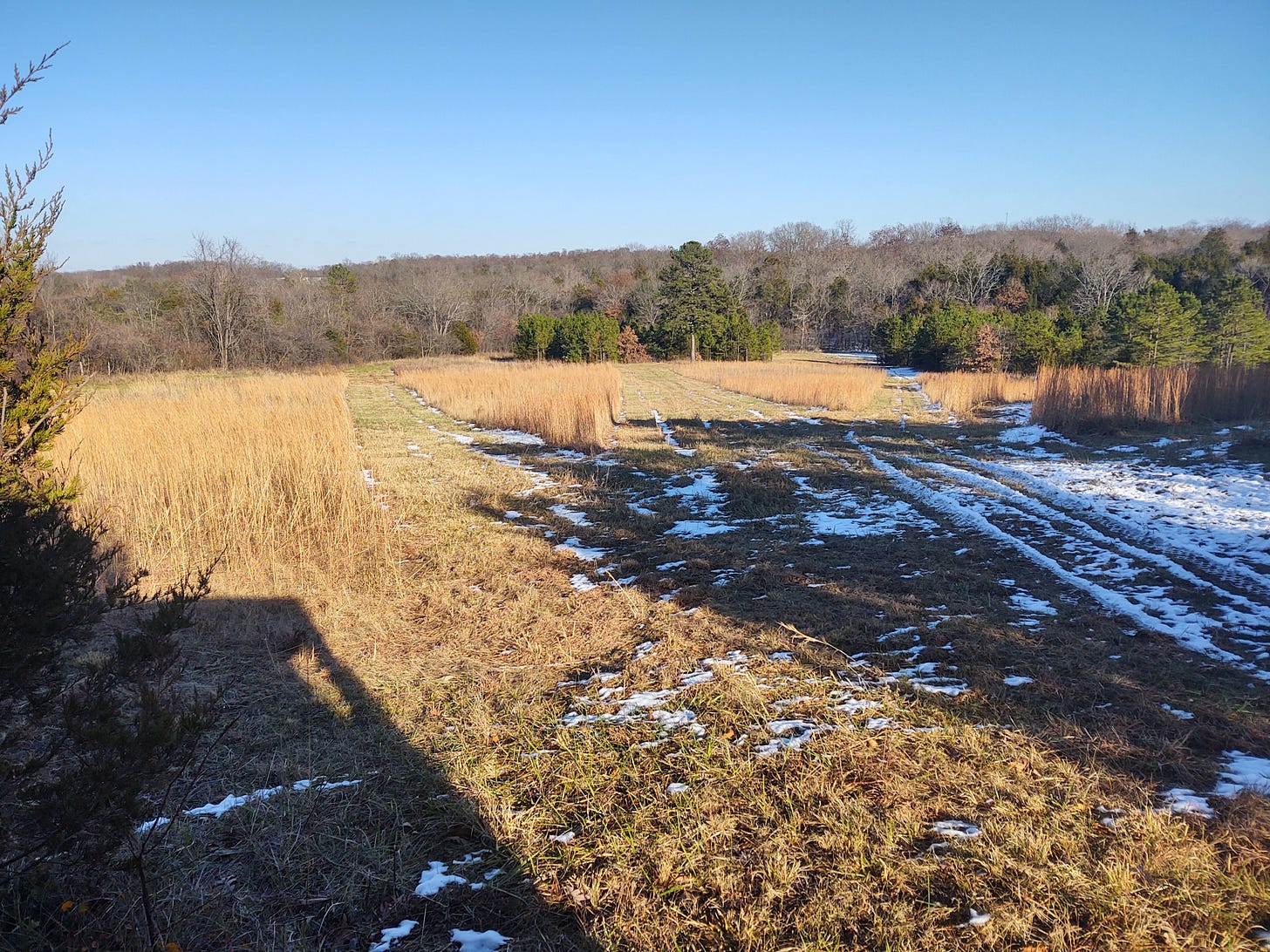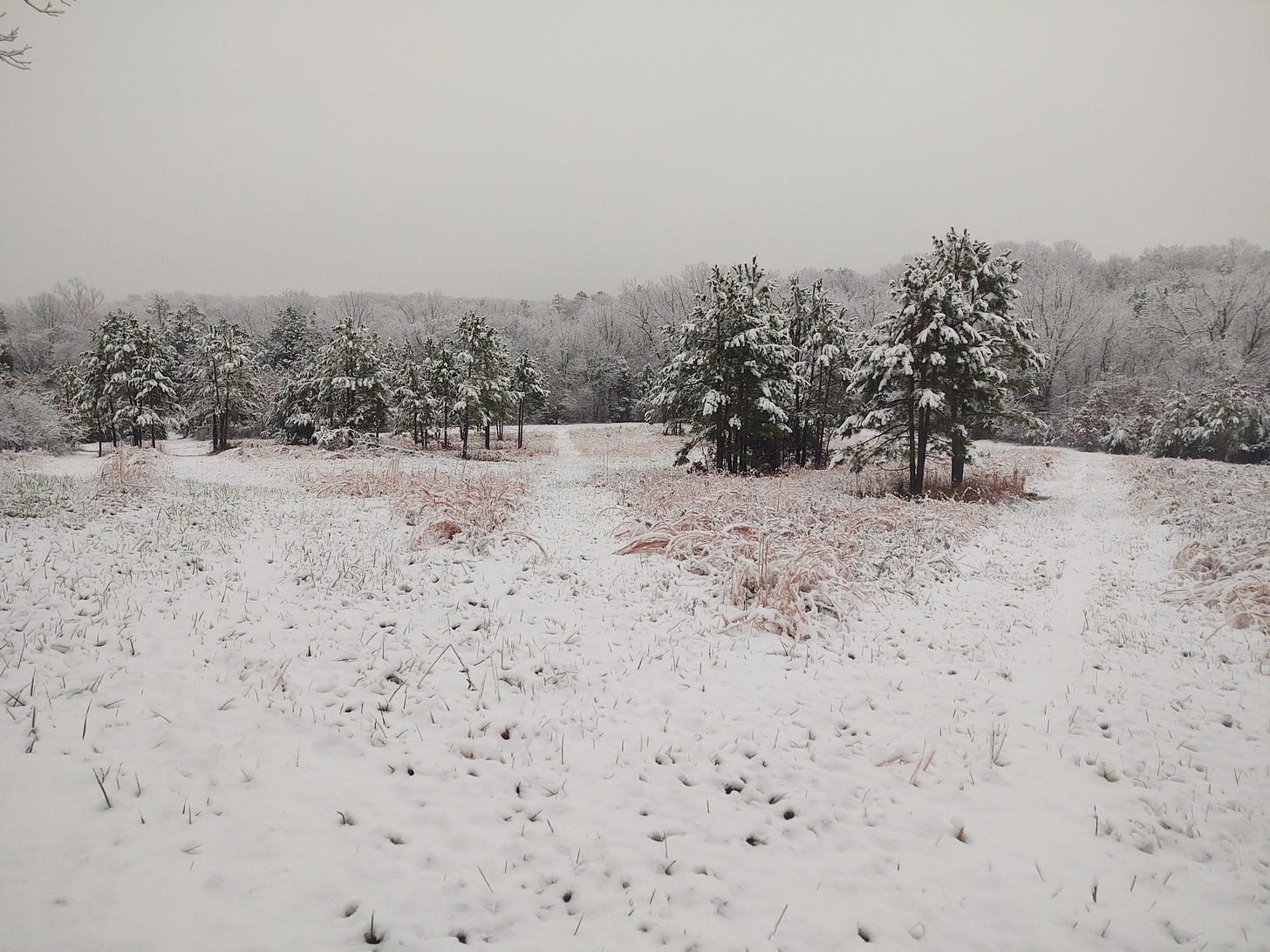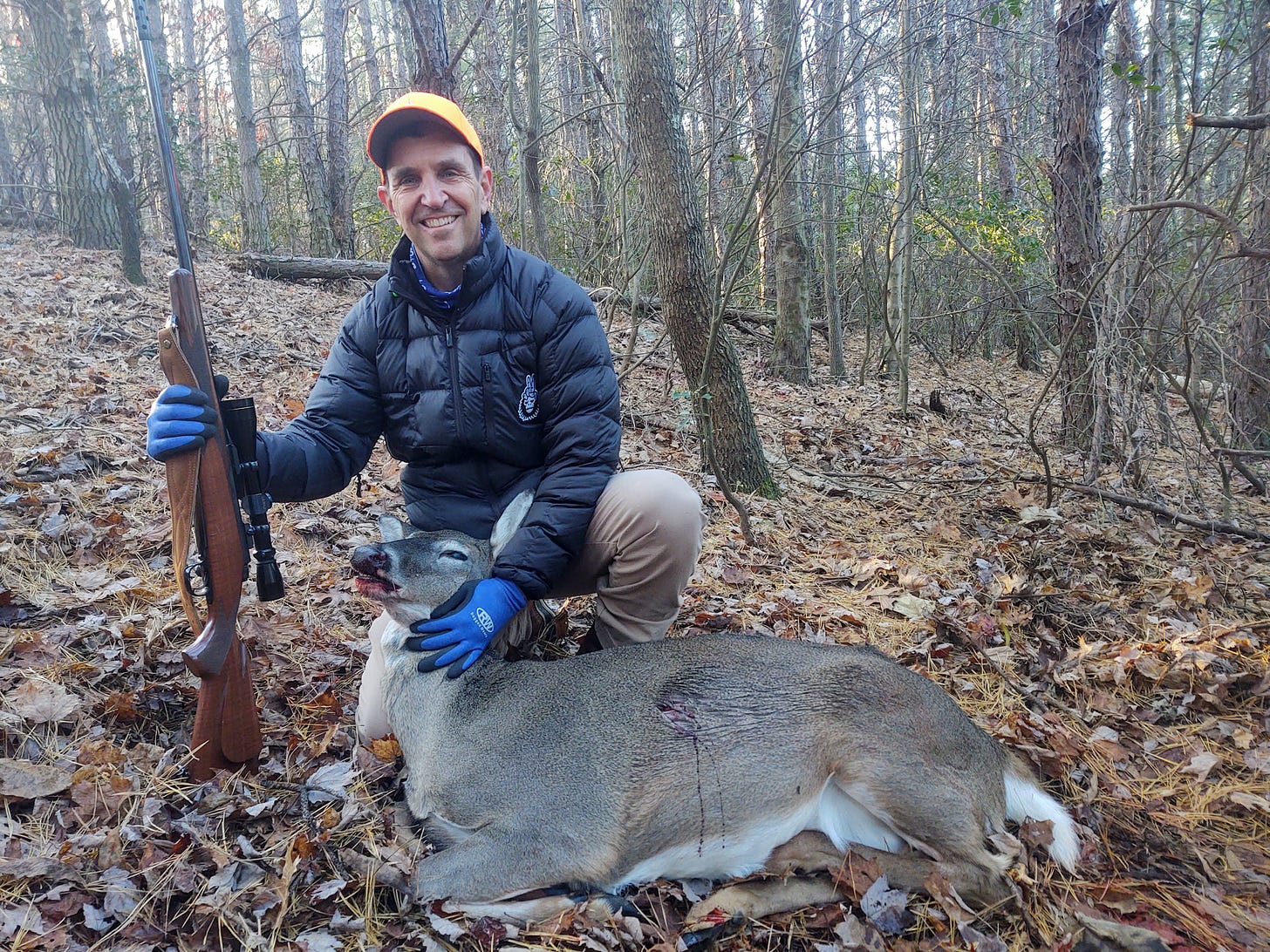You only get one shot ...
Is such a load of baloney, as I learned (again) deer hunting
This story appears in the current edition of Whitetails Unlimited. It is the lates installment of a long-running series in which I try new hobbies.
Updated 2023 burpee count: 7,647.
The afternoon sun stood high in the sky as I climbed into a deer blind for the first time in my life. As I watched the empty field in front of me, shadows from the trees to my right elongated until they reached an island of trees. The dying light turned the dead grass a muted brown—the same color as a deer.
“You could miss them if you’re not looking right at them,” said my friend Aaron, the owner of the property we were hunting on, and who sat with me during those crucial first hours of my hunting life. “Think how many deer there are around here. You don’t see that many, they’re so well camouflaged.”
The field in front of us was an ocean of knee-high grass with lanes cut into it. Wind whispered through the trees to our right. The only other sound came from my pen as it scratched across my notebook. “The ‘nothing happens’ is the best part,” I wrote, and I meant it; but I was so wrong, I’m almost embarrassed to admit it.
I only thought that because I hadn’t seen a deer yet.
And when I did, it changed everything.
I knew before my first deer hunting trip that I would love the camaraderie. I knew I would love the silence. I knew I would love the nature I buried myself in.
I did not know how much I would love the thrill of the hunt.
I found out when I returned to that blind the next morning. Ice glistened on the tall grass. Sunlight crept toward me, just as the shadows had crept away the night before. I watched, listened, and moved my feet closer to the heater. A brown fluff of movement caught my eye. A deer too far away to try to shoot emerged from behind a stand of trees. It turned half-toward me and started walking. Now I could see it was a she. Closer, closer, closer. Soon she was within range and turned broadside. This is it, I thought. I picked up my gun, looked through the scope, tried to line up the shot—HEY WHERE ARE YOU GOING?!?—she scampered away.
I’ve made a hobby of trying new hobbies over the last 10 years—surfing, rock climbing, ice climbing, dog mushing, long-distance bike riding, adventure racing, pickleball, and more. I love immersing myself in new activities because of the people I meet and because it allows me to live a life of never-ending learning. That encounter I described above—in which I learned to always be ready—was one of many lessons from my first deer hunting season. If you’re think- ing of trying this sport—or encouraging someone else to try it—here’s what you need to know.
Find your friends/relatives who hunt
Under no circumstances would I have done this alone. I would only have started with friends like Aaron and his twin brother, Nate.
Hunters love to share their passion, but they don’t all love to share their limited hunting time. So be mindful that “Will you take me hunting?” is a big, big ask.
Still, you probably have a friend/relative who will say yes.
This is not a small commitment on your part either, so I encourage you to think about sitting alone in the woods with this friend/relative for hours on end.
Will you be comfortable simply being with him or her for that long and not talking? Will you be comfortable asking them countless questions? Will they be comfortable answering them?
It’s got to be someone you know well and trust.
Take the hunter safety class (Required)
The state I live in (Missouri) offers the class online. There were nine units, each with a quiz at the end, and a “final exam” that you must pass to get your permit. Be prepared to spend hours reading, watching videos, and taking quizzes and the final exam.
It will cost as much or as little as you want
If you don’t have a friend or relative to take you, you could hire a guide for your first hunt. My suspicion is that many people either can’t afford it or don’t want to spend that much money on a hobby they’re not sure they’ll do again. In addition to hunting with Aaron and Nate, I also used a guide at Primland, an exclusive lodge in the Blue Ridge Mountains, but that was paid for because I was a journalist on assignment.
The rest of this adventure was done on a shoestring budget. Indeed, the whole project started when I asked Aaron, “How much would a rifle set me back if I wanted to go hunting with you?”
“Nothing,” he said, “You can borrow one of mine.”
Gear is another big expense that, frankly, you probably don’t need. I own cold-weather gear; it’s not made for hunting, but it kept me warm. The likelihood of my non-camo gear being the difference between getting a deer and not was essentially zero. “You don’t need to go buy the fanciest camouflage clothes that are out there,” said Kevyn Wiskirchen, a private lands deer biologist with the Missouri Department of Conservation, and a lifelong hunter.
“Deer see mostly in monochrome, except for blue,” Wiskirchen said. I spent all of my time in tree stands, blinds, and box stands, where in some cases deer couldn’t see me at all.
“Motion is a lot bigger deal than color,” Wiskirchen said. “Just being still—or when you’re moving, doing it really slowly—is the most important key to them not spotting you.”
Hunt on private property
The vast majority of land is privately owned, and the vast majority of deer are harvested on privately owned land.
I would have been reluctant to hunt on public property; I would not have done so alone. Conflict happens, and I worried I’d cause it through ignorance of social and/or cultural norms. That’s why I was thrilled to be able to hunt with Aaron and Nate on property they own with their brother and parents. “For first-time hunters, if there’s an opportunity to go on private land with a mentor who controls that property and can show you the ways, that’s certainly an ideal situation,” Wiskirchen said.
Think about your why
This section wouldn’t have been necessary in a story about any of those other hobbies I’ve tried. But I need to say it: I entered the sport with almost zero misgivings. I believe in conservation. I am not passionate about guns, but I respect people who are. I am a lifelong meat eater. Still, it’s a long walk from eating venison to pulling the trigger. I thought about it for a long time to prepare myself and continued to wrestle with it after I was done hunting. One of my best friends told me flatly he could not do it.
Another friend who is also a new hunter saw a big buck this year, the first deer he ever saw while hunting. With his shot lined up and his finger on the trigger, he stopped to think, “Am I going to kill this animal?” His answer was yes, but in that brief pause, the buck ran away.
Check out where you’re going to hunt beforehand
I have been to Aaron’s property many times but had never been there to hunt. He invited me to join him and Nate there a month before the season started for what
I dubbed “hunting practice,” and that time proved invaluable. I shot the rifle he let me borrow and toured the property on an ATV to get a close look at the tree stands.
I had been nervous about hunting from one. The hunter safety course made it sound like I’d be sitting on razor blades on top of a rickety ladder in the middle of a hurricane, and the question was not if I would fall off, but when. However, I realized in just a few minutes sitting in them that it wasn’t nearly that bad.
I helped clear out brush and cut down small trees near each stand to give us better views and bigger shooting lanes. That made me feel useful, considering how much Aaron and Nate were doing for me by providing a rifle, property, place to sleep, and an on-the-ground, live hunt- ing education along the way. “They’re all pretty shaggy this year so we’re spending more time cleaning them up,” Aaron said. “It helps a lot. There’s nothing worse than being out there, and you know there’s a deer, and you don’t have a shot.”
That’s all true, and so is this: any day I use a chainsaw, ride an ATV, and shoot a rifle is a good one.
Hunting is the means, not the end
In three days hunting at Aaron’s property, I saw seven deer. An experienced hunter would have had a chance at six of them— the seventh was running in the distance.
Once, I arrived at a tree stand at the exact moment as a deer. We were so close, I could have thrown a baseball and hit her, but I had been walking through icy snow, and I was about to climb a ladder, so my rifle was not loaded. If I had arrived three minutes earlier and ascended the stand, she would have been directly below me.
Another time, I stuck my phone out the viewing hole of a blind to take a picture of glistening snow. I looked away from the field to set my phone down. When I looked toward the field again, a doe—broad-shouldered, majestic, stock still—stood smack in the middle of a trail 40 yards from me. I can only guess she came from the woods to the left, but how she got there without me seeing or hearing her, I have no idea.
She stood broadside, a hunter’s dream. I slowly moved to get my rifle. She saw me, jerked her head toward me as if to say, not today, and bounded straight away before making a sharp left turn into the woods.
Another time, I fired one shot at a deer at the very far end of my shooting zone, and missed. We found tufts of white fur but no blood. I felt foolish, I must confess. Beforehand, I promised myself that my first shot would be a “can’t miss,” and by definition, I failed.
Even though I didn’t get a deer, the experience with Aaron and Nate was a smashing success. The point of deer hunting is not to harvest deer, or at least it’s not the only point. Statistics bear that out. According to stats provided by Wiskirchen, Missouri has roughly 485,000 hunters, but the average harvest over the last five years is only about 290,500 per year. Considering that many hunters get more than one deer, that means untold thousands go home empty- handed and yet return to the woods year after year.
I learned why when I was in the blind, on the tree stand, and while walking in the woods. The true point of deer hunting is friendship, camaraderie, and fun.
While eating and relaxing during downtime, Aaron, Nate, and I laughed often—with and at each other. One morning, Nate offered to show me how to get to Old Faithful, a tree stand that earned that moniker because many deer have been harvested from it. As we walked along the trail, he pointed to a pile of scat. “That looks fresh,” he said.
He bent over and picked up a couple pieces and rubbed them between his fingers, as if inspecting them for acorns or some other nut.
That’s what I thought at least.
Then he popped the scat in his mouth and ate it.
I fell for it for roughly .5 seconds.
Because it wasn’t scat, it was Raisinettes, and he had planted them there an hour earlier in anticipation of pranking me.
Take advantage of opportunities
I’m a freelance magazine writer. As I was reporting this story, Primland, a luxurious lodge in the Blue Ridge Mountains of Virginia, pitched me to write a story.
I couldn’t do what they proposed, but I asked if they would make one of their hunting guides available for an expert interview. One thing led to another, and the next thing I knew, they offered to fly me to Virginia to hunt there. I said yes to that, of course.
My guide, Sammy Howell, picked me up at the lodge at 5 a.m., and we talked strategy and technique. He explained how to shoot, both with a rifle for deer hunting and shotgun for clay pigeons, better than anybody I have ever heard. I felt like a better shot just by listening. Later, with him coaching me, I hit the first six clay pigeons I shot at; I had never hit six in a row in my life.
In the hour we talked before my hunt at Primland, Howell told me the top priority to get my first deer was to get a good, clean shot at a nice deer and not care about the difference between a doe and buck.
The sun was just peeking over the mountains as he drove me to my box stand. It sat in a swath of green grass roughly the size of a football field, with forest on all sides. Windows gave me a view of the entire field. I had to force myself to watch the field and not gape at the mountains behind it on the right.
I happened to be looking at the exact right spot when two brown noses emerged from the woods. Their bodies followed— a small deer and a big doe. I watched as they entered the field. I checked the time. It was 7:54 a.m.
Howell had told me to watch a doe to see if she looked back or gave any other indication that a buck was following her. The little one looked back repeatedly, but the big one never did. I didn’t know how long I should wait for a buck, but after several minutes, I decided that was enough. Howell’s advice to shoot when I had a good chance rang in my ears. I thought of his instruction: he had made crosshairs out of his fingers and held them against the steering wheel as if the Ford logo on it was the target. His fingers shook slightly as he said something like, Nobody holds it perfectly still. The way to make a good shot is to gently squeeze the trigger. When you yank the trigger, the barrel yanks with it, and you miss.
This was my moment of truth. I thought I was ready, but I realized I had more thinking to do. I re-argued with myself about whether I wanted to kill one of God’s creatures. There would be no turning back once I shot. I decided I had already decided I was OK with it. And yet I thought about it some more.
Finally, I picked up the .300 Winchester Magnum that Primland let me borrow. I rested the barrel on the window ledge to steady it, lined up the shot, and calmed myself. The crosshairs moved, ever so slightly, just as Howell said they would. My heart rate, 69 before I saw the deer, soared to 118 after they walked out. It was now back down to in 80’s.
I gently squeezed the trigger ... a little more ... a little more ... and ... and ... click.
Are you kidding me?!?
I had chambered a round, but it jammed.
I chambered another one, lined up the shot again, calmed myself again, and waited.
Anytime I do something new, I visualize how it will happen. I had mentally rehearsed how I hoped my first shot would go. This was pretty close—a clean, short, easy shot. It was like shooting the broadside of a couch. I’m not sure why, but as I envisioned my first shot beforehand, the deer’s head was always up. Right now, it was down. I waited, waited, waited. She lifted her head up. I held the crosshairs as steady as I could. I gently squeezed the trigger ... BAM!
Holy hell that was loud. It felt like my left ear plug blasted out of my ear. The deer ran directly away from me, then turned hard right into the woods. She ran so fast I thought I had missed.
I used the Walkie Talkie to tell Howell, “I just shot at one, but I’m not sure if I hit it.” He heard the sadness and disappointment that I felt.
The longer I looked at the field, the more sure I was that I had missed. I thought I might have to give up hunting if I couldn’t make an easy shot like that. The temperature hadn’t changed, but I shivered.
After 30 minutes or so, Howell and Billy Handy, another guide, arrived. We walked to the spot in the field where the doe had been standing. We found a splash of blood, then a second splash, then a whole bunch, and there the deer was, maybe 30 yards into the woods.
Upon finding the entry wound, Howell said he was surprised she hadn’t dropped dead on impact. My shot was square in the kill zone. Howell took pictures for me using my phone. Together, the three of us carried her out.
My hunting buddies all gave me a hard time because I let Howell and Handy gut the deer. Normally I would jump in and help with something like that—because it’s one more experience to learn from. I regret that I didn’t. I’ll gut the next one.




